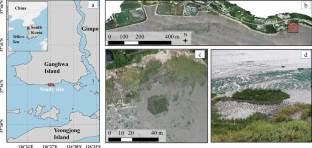Wetlands Ecology and Management ( IF 1.8 ) Pub Date : 2024-03-29 , DOI: 10.1007/s11273-024-09983-2 Wonhyeop Shin , Jinhyun Kim , Youngkeun Song , Hojeong Kang , Chaeho Byun

|
Spartina anglica, an invasive marsh grass, was designated as a harmful marine organism in 2016 due to its ability to stabilize mudflats and reduce macrobenthic diversity. To control such invasive species, physical, chemical, or biological methods can be applied while chemical methods are prohibited by law due to ecological disruption. However, the preferred methods of soil tillage, cutting, and native plant restoration for managing S. anglica have rarely been analyzed. To compare the methods, we performed 9 treatments with four replicates, comprising control, different frequencies of clipping (once and twice) and tilling (once and twice), and different densities (50 and 100 seedling) of restoration of the native plants Suaeda japonica and Phragmites australis. To evaluate the severity of disturbance, we measured coverage, stem density, average plant height, and above-ground biomass for 2 years. We found P. australis and S. japonica did not successfully establish or survive due to niche differences and the inherent biological features of Spartina. However, physical removal had a stronger effect than interspecific interaction. Two cutting treatments in the early and the late growing season reduced plant height and biomass of S. anglica by 6 and 34%, respectively, compared with the control treatment at the rapid vegetative growth stage in the following year. We also found that two tillage treatments reduced biomass, plant cover, and stem density by 32%, 38%, and 83%, respectively, in the following year. In the study site, managing invasive species such as S. anglica is best achieved by physically destroying the plant using soil tillage while attempting to restore native species had marginal control effects.
中文翻译:

土壤耕作对滨海湿地大米草入侵的防治效果
大米草是一种入侵性沼泽草,由于其稳定泥滩和减少大型底栖动物多样性的能力,于 2016 年被指定为有害海洋生物。为了控制这些入侵物种,可以采用物理、化学或生物方法,而化学方法由于生态破坏而被法律禁止。然而,用于管理英国虎尾草的首选土壤耕作、砍伐和本土植物恢复方法却很少被分析。为了比较这些方法,我们进行了 9 个处理,四个重复,包括对照、不同修剪频率(一次和两次)和耕作(一次和两次)以及不同密度(50 和 100 株幼苗)恢复本土植物碱蓬和芦苇。为了评估干扰的严重程度,我们测量了两年的覆盖率、茎密度、平均株高和地上生物量。我们发现,由于生态位差异和大米草固有的生物学特征,南方大米和日本大米未能成功建立或生存。然而,物理去除的效果比种间相互作用的效果更强。生长季前期和后期的2次刈割处理,与翌年营养快速生长期对照处理相比,使白术株高和生物量分别降低了6%和34%。我们还发现,两次耕作处理在次年使生物量、植物覆盖度和茎密度分别减少了 32%、38% 和 83%。在研究地点,管理诸如英国虎尾草等入侵物种的最佳方法是通过土壤耕作对植物进行物理破坏,同时尝试恢复本地物种的控制效果有限。



























 京公网安备 11010802027423号
京公网安备 11010802027423号